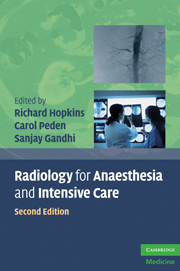Book contents
- Radiology for Anaesthesia and Intensive Care
- Radiology for Anaesthesia and Intensive Care
- Copyright page
- Dedication
- Contents
- Contributors
- Acknowledgements
- Introduction
- Aboutthe FRCA examination
- Thepre-operative assessment
- 1 Imaging the chest
- Chapter 2 Imaging the abdomen
- 3 Trauma radiology
- 4 The cervical spine
- Chapter 5 CT head
- 6 Anaesthesia in the radiology department. MRI and interventional radiology
- 7 Ultrasound
- Index
Chapter 5 - CT head
Published online by Cambridge University Press: 19 February 2010
- Radiology for Anaesthesia and Intensive Care
- Radiology for Anaesthesia and Intensive Care
- Copyright page
- Dedication
- Contents
- Contributors
- Acknowledgements
- Introduction
- Aboutthe FRCA examination
- Thepre-operative assessment
- 1 Imaging the chest
- Chapter 2 Imaging the abdomen
- 3 Trauma radiology
- 4 The cervical spine
- Chapter 5 CT head
- 6 Anaesthesia in the radiology department. MRI and interventional radiology
- 7 Ultrasound
- Index
Summary
- Type
- Chapter
- Information
- Radiology for Anaesthesia and Intensive Care , pp. 172 - 208Publisher: Cambridge University PressPrint publication year: 2009



